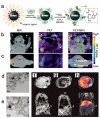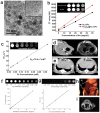Recent advances in engineering iron oxide nanoparticles for effective magnetic resonance imaging
- PMID: 35310380
- PMCID: PMC8897217
- DOI: 10.1016/j.bioactmat.2021.10.014
Recent advances in engineering iron oxide nanoparticles for effective magnetic resonance imaging
Abstract
Iron oxide nanoparticle (IONP) with unique magnetic property and high biocompatibility have been widely used as magnetic resonance imaging (MRI) contrast agent (CA) for long time. However, a review which comprehensively summarizes the recent development of IONP as traditional T 2 CA and its new application for different modality of MRI, such as T 1 imaging, simultaneous T 2/T 1 or MRI/other imaging modality, and as environment responsive CA is rare. This review starts with an investigation of direction on the development of high-performance MRI CA in both T 2 and T 1 modal based on quantum mechanical outer sphere and Solomon-Bloembergen-Morgan (SBM) theory. Recent rational attempts to increase the MRI contrast of IONP by adjusting the key parameters, including magnetization, size, effective radius, inhomogeneity of surrounding generated magnetic field, crystal phase, coordination number of water, electronic relaxation time, and surface modification are summarized. Besides the strategies to improve r 2 or r 1 values, strategies to increase the in vivo contrast efficiency of IONP have been reviewed from three different aspects, those are introducing second imaging modality to increase the imaging accuracy, endowing IONP with environment response capacity to elevate the signal difference between lesion and normal tissue, and optimizing the interface structure to improve the accumulation amount of IONP in lesion. This detailed review provides a deep understanding of recent researches on the development of high-performance IONP based MRI CAs. It is hoped to trigger deep thinking for design of next generation MRI CAs for early and accurate diagnosis.
Keywords: Dual-modal contrast imaging; Environment responsive imaging; Improved relaxation; Iron oxide nanoparticles; Strcture engineering.
© 2021 The Authors.
Conflict of interest statement
The authors declare that they have no known competing financial interests or personal relationships that could have appeared to influence the work reported in this paper.
Figures























Similar articles
-
Iron Oxide Nanoparticle-Based T1 Contrast Agents for Magnetic Resonance Imaging: A Review.Nanomaterials (Basel). 2024 Dec 28;15(1):33. doi: 10.3390/nano15010033. Nanomaterials (Basel). 2024. PMID: 39791792 Free PMC article. Review.
-
Toward absolute quantification of iron oxide nanoparticles as well as cell internalized fraction using multiparametric MRI.Contrast Media Mol Imaging. 2012 Jul-Aug;7(4):411-7. doi: 10.1002/cmmi.1467. Contrast Media Mol Imaging. 2012. PMID: 22649047 Free PMC article.
-
Stimuli-controllable iron oxide nanoparticle assemblies: Design, manipulation and bio-applications.J Control Release. 2022 May;345:231-274. doi: 10.1016/j.jconrel.2022.03.024. Epub 2022 Mar 16. J Control Release. 2022. PMID: 35306119 Review.
-
In Vivo Imaging and Quantification of Iron Oxide Nanoparticle Uptake and Biodistribution.Proc SPIE Int Soc Opt Eng. 2012 Mar 23;8317:83170R. doi: 10.1117/12.916097. Proc SPIE Int Soc Opt Eng. 2012. PMID: 25285189 Free PMC article.
-
Imaging and quantification of iron-oxide nanoparticles (IONP) using MP-RAGE and UTE based sequences.Magn Reson Med. 2017 Jul;78(1):226-232. doi: 10.1002/mrm.26371. Epub 2016 Aug 6. Magn Reson Med. 2017. PMID: 27495266 Free PMC article.
Cited by
-
Smart Molecular Imaging and Theranostic Probes by Enzymatic Molecular In Situ Self-Assembly.JACS Au. 2024 Jul 3;4(7):2426-2450. doi: 10.1021/jacsau.4c00392. eCollection 2024 Jul 22. JACS Au. 2024. PMID: 39055152 Free PMC article. Review.
-
Nucleic acid drug vectors for diagnosis and treatment of brain diseases.Signal Transduct Target Ther. 2023 Jan 17;8(1):39. doi: 10.1038/s41392-022-01298-z. Signal Transduct Target Ther. 2023. PMID: 36650130 Free PMC article. Review.
-
Advances in Atherosclerosis Theranostics Harnessing Iron Oxide-Based Nanoparticles.Adv Sci (Weinh). 2024 May;11(17):e2308298. doi: 10.1002/advs.202308298. Epub 2024 Feb 17. Adv Sci (Weinh). 2024. PMID: 38368274 Free PMC article. Review.
-
Iron oxide nanoparticles induce ferroptosis under mild oxidative stress in vitro.Sci Rep. 2024 Dec 28;14(1):31383. doi: 10.1038/s41598-024-82917-3. Sci Rep. 2024. PMID: 39733146 Free PMC article.
-
A CIA strategy with eminent drug-loading capacities for tumor ferroptosis-gas synergistic therapy.Theranostics. 2024 Oct 28;14(19):7349-7369. doi: 10.7150/thno.99295. eCollection 2024. Theranostics. 2024. PMID: 39659580 Free PMC article.
References
-
- Lane L.A., Qian X., Nie S. SERS nanoparticles in medicine: from label-free detection to spectroscopic tagging. Chem. Rev. 2015;115:10489–10529. - PubMed
-
- Taylor A., Wilson K.M., Murray P., Fernig D.G., Lévy R. Long-term tracking of cells using inorganic nanoparticles as contrast agents: are we there yet? Chem. Soc. Rev. 2012;41:2707–2717. - PubMed
-
- Barrow M., Taylor A., Murray P., Rosseinsky M.J., Adams D.J. Design considerations for the synthesis of polymer coated iron oxide nanoparticles for stem cell labelling and tracking using MRI. Chem. Soc. Rev. 2015;44:6733–6748. - PubMed
Publication types
LinkOut - more resources
Full Text Sources

